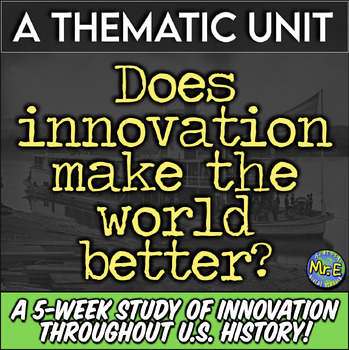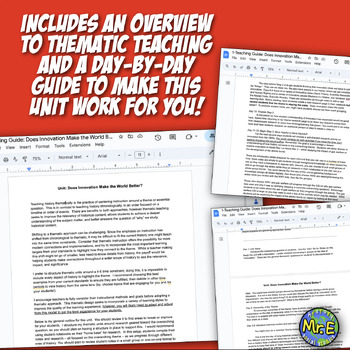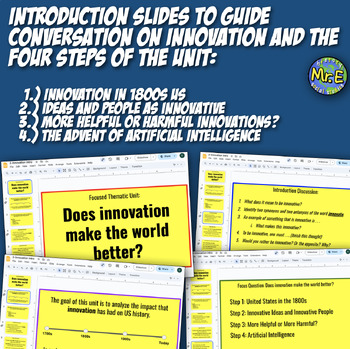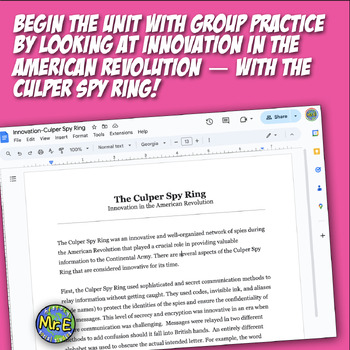US American History Thematic Unit | Does Innovation Make the World Better?
- Zip
- Google Apps™

What educators are saying
Products in this Bundle (4)
Bonus
Description
This thematic unit for United States or American History is designed around the overarching essential question, "Does Innovation Make the World Better?" This guided unit seeks to focus students on one theme over the five-week unit to better understand how innovation has shaped US history throughout different eras. This unit begins by examining innovation in the 1700s, 1800s, 1900s, and today, at each step focusing students on the overarching theme.
Throughout the unit, students examine the innovation of the Culper Spy Ring, a variety of inventions (Steel Plow, Mechanical Reaper, Pasteurization, Steamboat, Gatling Gun, Cotton Gin), a variety of ideas (Germ Theory, Human Rights, Scientific Revolution), a handful of innovative people (Granville Woods, Madame CJ Walker, the Navajo Code Talkers), the use of gas warfare in World War I, the development of the Atomic Bomb in World War II, and the use and development of Artificial Intelligence today.
This resource includes several files to help you implement this unit (or supplement it to what you already do).
Included in this download is:
1.) A teacher guide detailing the benefits of thematic instruction and how this unit is designed, organized, and the benefits of student-led research. This file also includes a sample day-by-day breakdown of instruction to help you organize and pace this unit.
2.) A unit guide that breaks down the four major steps of this unit. It outlines the initial debut of the unit, highlighted by group conversation and a practice reading on innovation in the Culper Spy Ring during the American Revolution.
- In Step 1, students focus on innovation in the 1800s and guided research on other inventions that have had disastrous consequences to US history.
- In Step 2, students focus on "innovative ideas and innovative people" by examining the Germ Theory, the advent of Human Rights, the Scientific Revolution, and innovative people like Granville Woods, Madame CJ Walker, and the Navajo Code Talkers of World War 2.
- In Step 3, students examine innovation that might be more harmful than helpful -- by examining gas warfare in World War I and the development of the atomic bomb in World War 2.
- Lastly, students research the use of Artificial Intelligence to understand its potential and dangers.
3.) A set of introduction slides to introduce the unit and guide conversation.
4.) A set of thematic slides for World War I to introduce the major causes of the war to provide context for the study of gas warfare.
5.). A set of thematic slides for World War II to introduce the major causes of the war to provide context for the study of the impact of the atomic bomb.





